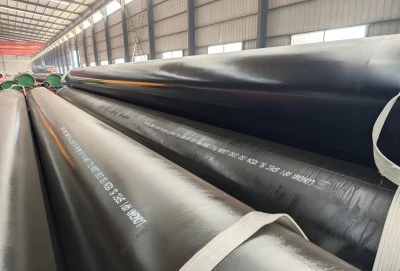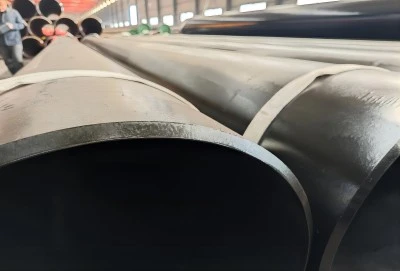When it comes to pipeline integrity and safety, the importance of thorough testing cannot be overstated. Among the various tests performed on API 5L PSL2 pipes, the hydrostatic test stands out as a crucial procedure. But is it really necessary? In this article, we'll explore the significance of hydrostatic testing for API 5L X52 PSL2 pipes, focusing on its role in ensuring pressure resistance, detecting weld defects, and meeting industry standards.
|
|
|
Ensuring Pressure Resistance
API 5L PSL2 pipes are designed to withstand high pressures in various applications, particularly in the oil and gas industry. The hydrostatic test is a fundamental method to verify the pipe's ability to handle these pressures without failure. During this test, the pipe is filled with water and pressurized to a level significantly higher than its intended operating pressure.
For API 5L X52 PSL2 pipes, the test pressure is typically set at 1.5 times the design pressure or 90% of the specified minimum yield strength (SMYS), whichever is lower. This rigorous testing ensures that the pipe can withstand the stresses it will encounter during its service life. By subjecting the pipe to these elevated pressures, manufacturers can identify any weaknesses or potential failure points before the pipe is put into operation.
The hydrostatic test is particularly crucial for API 5L PSL2 pipes because they are often used in critical applications where failure could have severe consequences. These pipes may be transporting hazardous materials, operating in environmentally sensitive areas, or be part of infrastructure that's vital to energy supply. In such cases, the assurance provided by a successful hydrostatic test is invaluable.
Moreover, the test helps verify the pipe's dimensional stability under pressure. Any significant deformation during the test could indicate issues with the pipe's manufacturing process or material quality. This information is vital for quality control and can help prevent costly failures in the field.
Detecting Weld Defects
One of the most critical aspects of API 5L PSL2 pipe integrity is the quality of its welds. The hydrostatic test plays a crucial role in detecting weld defects that might not be visible through other inspection methods. When the pipe is pressurized during the test, any weaknesses in the weld seams are put under stress, potentially revealing defects such as incomplete fusion, lack of penetration, or porosity.
For welded API 5L X52 PSL2 pipes, the hydrostatic test is particularly important. These pipes are often manufactured using processes like electric resistance welding (ERW) or longitudinal submerged arc welding (LSAW). While these methods are generally reliable, the hydrostatic test provides an additional layer of quality assurance. It can reveal issues that might have been missed during other stages of quality control, such as visual inspection or non-destructive testing.
The test is especially effective at detecting through-thickness defects that could lead to leaks. As the pipe is pressurized, any defect that penetrates the entire wall thickness will allow water to escape, making it easily detectable. This is crucial for maintaining the integrity of pipelines, as even small leaks can lead to significant problems over time.
Furthermore, the hydrostatic test can also reveal defects that might not cause immediate leakage but could grow over time due to fatigue or environmental factors. By subjecting the pipe to pressures well above its operating range, the test can identify areas of weakness that might fail prematurely under normal service conditions.
It's worth noting that while the hydrostatic test is excellent for detecting certain types of defects, it should be used in conjunction with other testing methods for comprehensive quality assurance. Non-destructive testing techniques like ultrasonic testing or radiographic inspection can provide complementary information about the weld quality and overall pipe integrity.
Meeting Industry Standards
The hydrostatic test is not just a good practice; it's a requirement for API 5L PSL2 pipes to meet industry standards. The API 5L specification, which governs the manufacturing of these pipes, mandates hydrostatic testing as part of the quality control process. This requirement ensures that all pipes certified under this standard have undergone rigorous pressure testing, providing a baseline level of quality and reliability across the industry.
For API 5L X52 PSL2 pipes, compliance with these standards is crucial. Many end-users, particularly in the oil and gas industry, specify API 5L compliant pipes in their project requirements. The hydrostatic test is a key component of this compliance, and without it, the pipes cannot be certified as meeting the API 5L standard.
The standardization of testing procedures, including the hydrostatic test, allows for consistency and comparability across different manufacturers and production batches. This is particularly important in an industry where pipes from various sources may be used in the same project. The assurance that all pipes have passed the same rigorous testing procedures provides confidence in the overall integrity of the pipeline system.
Moreover, adherence to these standards is often a regulatory requirement in many jurisdictions. Government agencies responsible for pipeline safety may mandate the use of API 5L compliant pipes, including the requirement for hydrostatic testing. This ensures that pipelines meet minimum safety standards and helps protect public and environmental safety.
The hydrostatic test also plays a role in quality management systems. Many pipe manufacturers use the results of these tests as part of their continuous improvement processes. By analyzing test data over time, they can identify trends, refine manufacturing processes, and ultimately produce higher quality pipes.
It's important to note that while the API 5L standard sets minimum requirements for hydrostatic testing, many manufacturers and end-users may choose to implement even more stringent testing protocols. This can include longer test durations, higher test pressures, or additional acceptance criteria beyond what the standard requires.
Contact Longma Group
In conclusion, the hydrostatic test is not just necessary for API 5L X52 PSL2 pipes; it's an indispensable part of ensuring their quality, reliability, and safety. This test plays a crucial role in verifying pressure resistance, detecting weld defects, and meeting industry standards. By subjecting pipes to pressures well above their operating range, manufacturers can provide assurance that the pipes will perform safely and reliably in the field.
While the hydrostatic test is a powerful tool, it's important to remember that it's just one part of a comprehensive quality assurance process. When combined with other testing methods and rigorous manufacturing practices, it helps ensure that API 5L PSL2 pipes meet the high standards required for critical applications in the oil, gas, and other industries.
For those in need of high-quality API 5L PSL2 pipes, including the X52 grade, Longma Group offers a wide range of products that meet and exceed industry standards. Our pipes undergo rigorous testing, including hydrostatic tests, to ensure their reliability and performance. Don't compromise on quality when it comes to your pipeline projects. Contact us at info@longma-group.com today to learn more about our API 5L PSL2 pipes and how they can meet your specific needs.














